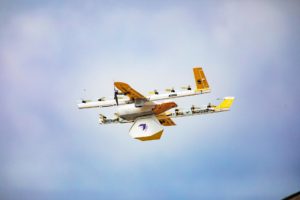 Google spin-off Wing has made history in drone delivery. As the first recipient of a Part 135 certificate to operate as a commercial drone airline in the U.S., they’ve brought drone delivery out of the realm of emergencies and made it available to consumers: delivering local food, products, drugstore supplies and even library books to the doorsteps of suburban homes.
Google spin-off Wing has made history in drone delivery. As the first recipient of a Part 135 certificate to operate as a commercial drone airline in the U.S., they’ve brought drone delivery out of the realm of emergencies and made it available to consumers: delivering local food, products, drugstore supplies and even library books to the doorsteps of suburban homes.
Throughout the process of negotiating with aviation authorities around the world, Wing has acquired a deep understanding of what it takes to integrate commercial drone flights into the skies. The company has gathered data on more than 100,000 flights; they’ve received feedback from customers and surrounding communities; and they’ve performed delivery operations safely and accurately. In Australia, Finland, and the U.S., thousands of customers have used the service over the last two years.
All of that experience has contributed to the development of their other, less-well known to the public but no less important, offering: OpenSky, Wing’s unmanned traffic management (UTM) solutions. A version of OpenSky available to consumers launched last year in Australia: OpenSky is what Wing uses to manage their drone delivery programs. The system provides complex flight planning mechanisms, deconfliction, and communication with airspace authorities.
Reinaldo Negron is Wing’s Head of UTM, and co-president of the Global UTM Association (GUTMA.) Negron joined Wing in 2016, when UTM was still a concept being discussed with NASA, a long way from being a real solution used to support a consumer drone delivery program. “It’s been really exciting to go from paper to real life,” says Negron.
Open Skies for All
Wing has taken a unique and open approach to developing UTM: they believe there is room for – and a need for – multiple suppliers. “We take a collaborative approach,” says Negron. “We don’t think there is one system that applies for every type of flight, for every application – we think it will take an ecosystem to help this entire industry take off.”
At the heart of the approach is an understanding that the drone industry includes a vast array of different operations: drone delivery may need a different type of system than inspection drones do, recreational flyers have different requirements than commercial drone operators. “We think that this federated approach, involving private industry, is necessary,” Negron explains. “It would be too difficult for one federally funded system to develop as quickly as needed to support all types of operations. That’s why we’re so supportive of this ecosystem approach.”
Wing has been involved with GUTMA and standards development in the U.S. and around the world: they’ve worked with NASA UTM testing; as part of the low altitude authorization and notification (LAANC) project; and most recently, as part of the Remote ID for drones (RID) cohort. “We’ve been able to bring to real life the collaboration with others – we’ve flown not just Wing drones, but DJI drones and other types,” says Negron.
InterUSS: Open Source for Aviation
“We want to make sure we are all safe and deconflicted in our access to the sky,” he explains. “We also support open source software: to allow all UTM companies to plug and play together.”
The open source software is called InterUSS. InterUSS is the answer to the question of how Wing’s OpenSky will communicate with, for example, AirMap; in order to allow operators using both systems to share information for deconfliction.
“Seeing open source come to aviation is a really exciting step – it makes sure we can have a broad and diverse ecosystem of providers,” says Negron. Uber, AirMap, Swiss regulators, and others are using the software, which is now part of the LINUX foundation.
OpenSky will expand as standards are developed, rules are passed, and the framework for a collaborative UTM ecosystem comes together. “OpenSky is more of a suite of capabilities – we can imagine multiple products coming down the pike,” says Negron.
“The goal here is to make compliance as easy as possible for the most operators,” says Lia Reich, Wing’s Senior Communications Specialist. “We and other companies are making these more broadly available to make sure the industry can grow.”

Miriam McNabb is the Editor-in-Chief of DRONELIFE and CEO of JobForDrones, a professional drone services marketplace, and a fascinated observer of the emerging drone industry and the regulatory environment for drones. Miriam has penned over 3,000 articles focused on the commercial drone space and is an international speaker and recognized figure in the industry. Miriam has a degree from the University of Chicago and over 20 years of experience in high tech sales and marketing for new technologies.
For drone industry consulting or writing, Email Miriam.
TWITTER:@spaldingbarker
Subscribe to DroneLife here.







[…] reduce physical human interaction. See for instance the increased use of food deliveries via drones operated by Google outfit Wing, which has now conducted over 100,000 commercial drone flights. There are […]